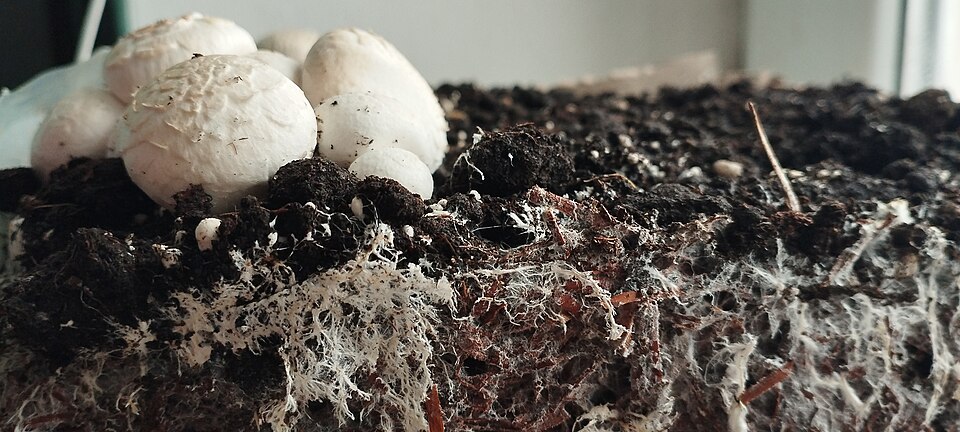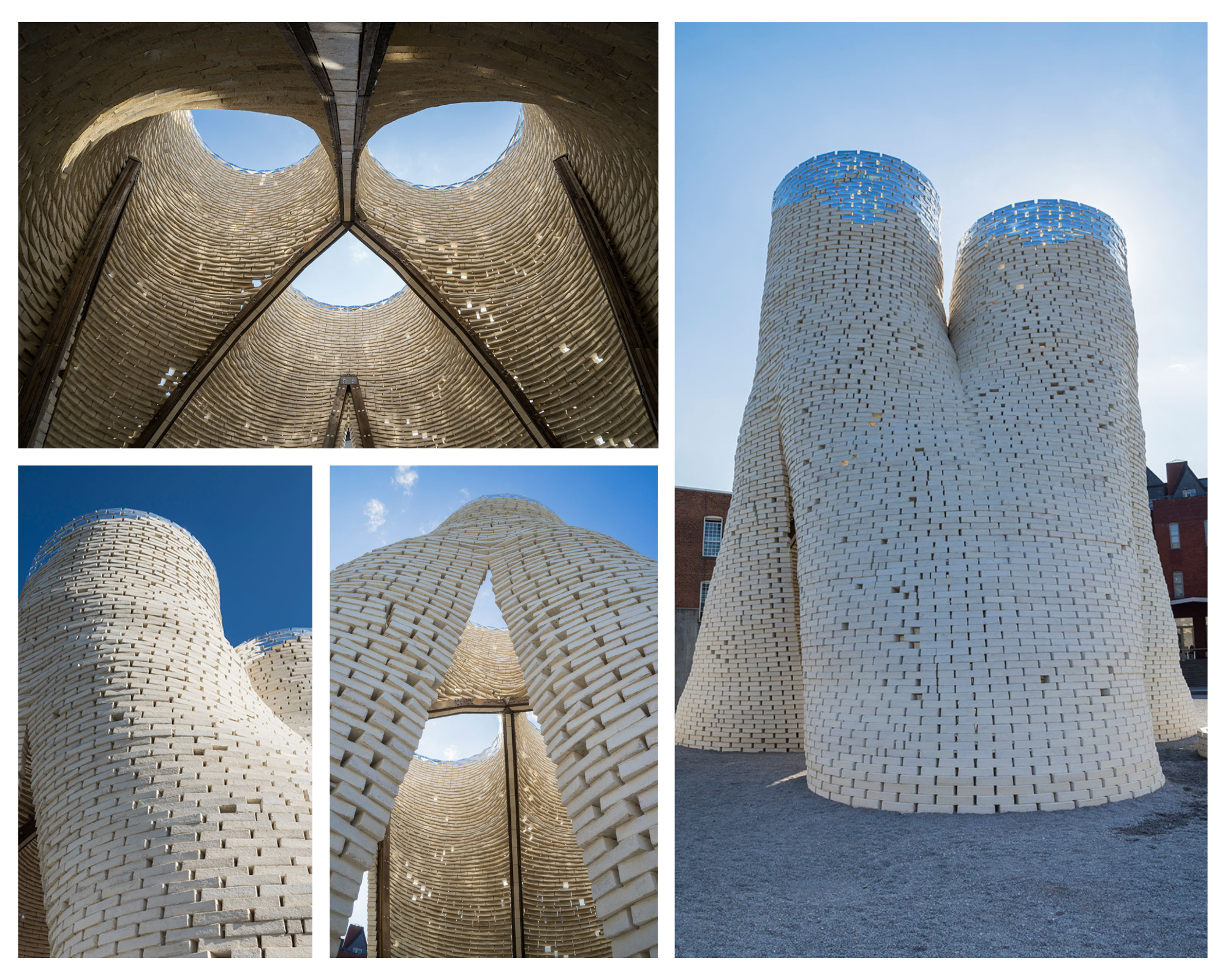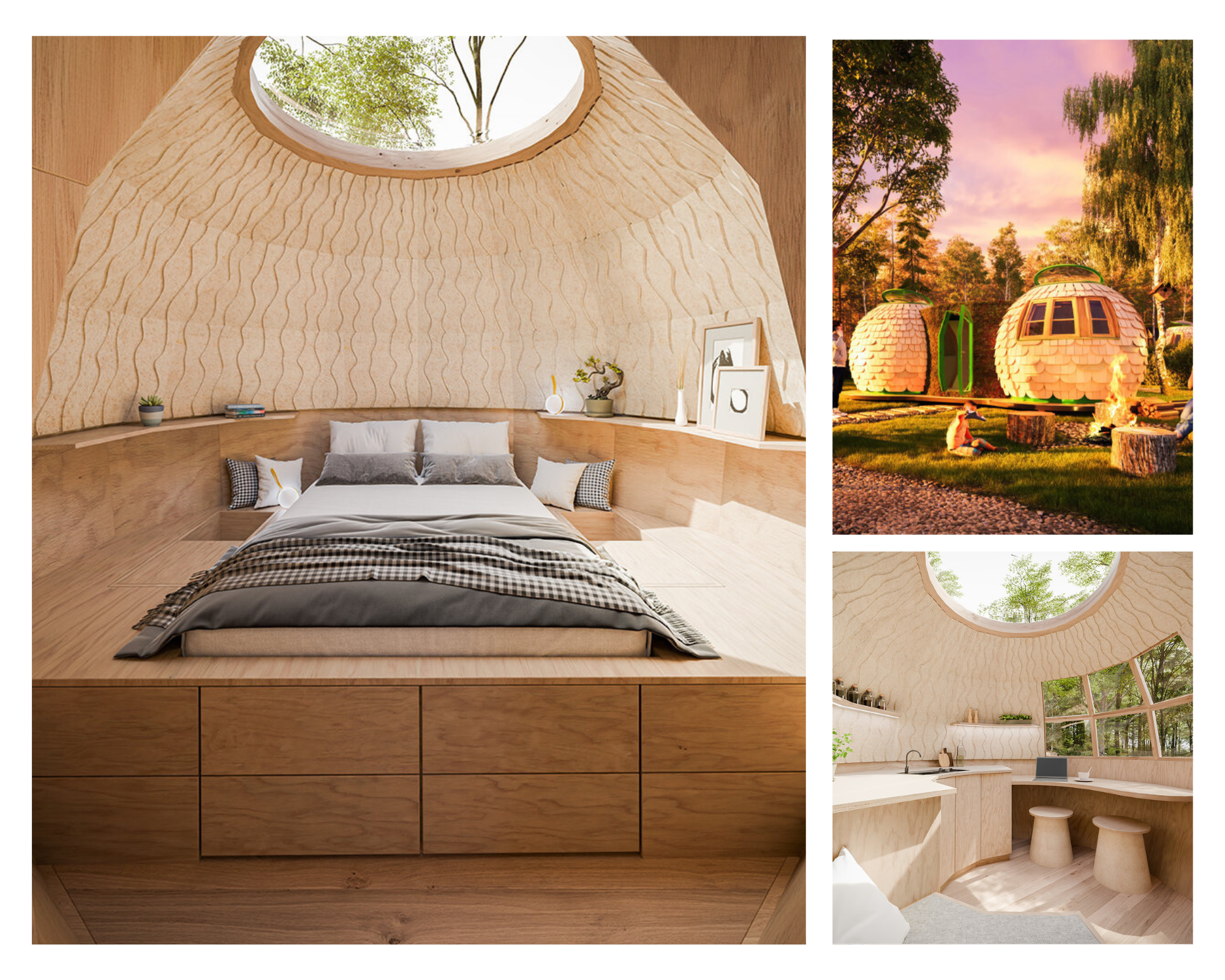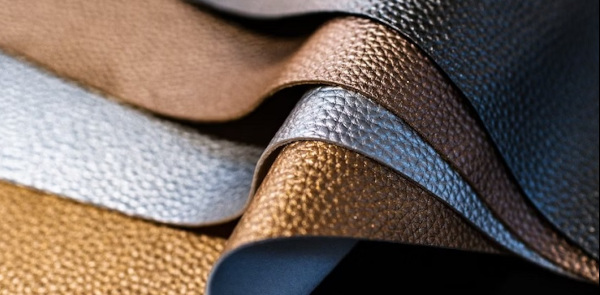Mycelium: living material that could revolutionise architecture and construction
- What is mycelium and how is it used in construction?
- Learning from inside the mushroom: orientation, not composition
- Building with fungi: mycelium in contemporary architecture
- Hy-Fi: a tower of living bricks
- Biohm: construction materials cultivated with waste and mycelium
- Samorost: the first mycelium house
- Technical challenges and emerging solutions
- Furniture and interior design with mycelium
- Designing by cultivating: objects that grow in molds
- Lamps, chairs, and textures that evoke the living
- Mycelium as fungal leather
- What makes mycelium so interesting for designers?
- Cultivated cities: the urban potential of mycelium
- Biodegradable urban infrastructure
- Real obstacles and future possibilities
- Towards regenerative construction
Can you imagine living in a cultivated house, made from mushrooms, that breathes, repairs itself, and at the end of its useful life, silently reintegrates into the forest or urban soil from which it came? Far from being science fiction, the revolution of living materials has already begun, and mycelium —the underground structure of fungi— presents itself as one of the most promising candidates to build the future.
What is mycelium and how is it used in construction?
Mycelium is the underground network of filaments that constitutes the base of the fungal kingdom. Each of these filaments is called a hypha: microscopic, elongated, and branched structures that grow forming complex webs. When interwoven, hyphae create a continuous tissue capable of absorbing nutrients, decomposing organic matter, and establishing symbiotic connections with plants, bacteria, and other soil organisms.
Often invisible, this network acts as the digestive and nervous system of fungi, and fulfills an essential ecological role in ecosystems. But beyond its natural functions, mycelium presents physical properties that make it ideal as a sustainable construction material. Its ability to expand, consolidate, and adhere to different substrates makes it a surprisingly versatile structural base.

When cultivated under controlled conditions —using agricultural waste as food—, mycelium colonizes its environment and binds it together like a biological cement. In a matter of days, it forms solid, lightweight, resistant, fire-retardant structures with thermal and acoustic insulation properties. And perhaps most importantly: it is biodegradable and compostable, completely integrated into the natural cycle of life.
Compared to materials like concrete, plastic, or plaster, mycelium generates no net CO₂ emissions during its cultivation or manufacturing; on the contrary, it absorbs it during its growth. It's a low-impact, scalable alternative aligned with the circular economy.
Learning from inside the mushroom: orientation, not composition
A group of engineers from Binghamton University and UC Merced has demonstrated that the key to creating stronger and lighter materials lies not in their composition, but in their internal architecture. By studying how hyphae —the filaments that compose mycelium— are organized within different mushroom species, they discovered that the orientation of these fibers radically influences the mechanical properties of the material.
Specifically, they analyzed two types of edible mushrooms: the white button mushroom (Agaricus bisporus), with randomly distributed hyphae, and the maitake (Grifola frondosa), whose hyphae are aligned in a single direction. Through electron microscopy, compression tests, and 3D simulations, they verified that a simple reorganization of the tissue doubled the material's stiffness, without adding new ingredients or modifying the chemistry.
This finding, published in Advanced Engineering Materials, suggests that copying the hidden patterns in mushrooms could inspire new materials bio-inspired for architecture, packaging, medicine, or aviation. It's not about inventing more, but observing better: nature has already designed what we need.
Building with fungi: mycelium in contemporary architecture
Although it sounds like science fiction, the truth is that mycelium has already been used to erect walls, build experimental structures, and design habitable spaces. For now, its applications have mainly occurred in artistic, ephemeral, or pilot contexts. But these first fungal constructions not only reveal the potential of living materials, but also open the door to a new way of understanding architecture: biological, regenerative, and completely biodegradable.
Hy-Fi: a tower of living bricks
One of the most emblematic examples is the Hy-Fi Tower, built in 2014 by The Living studio (directed by David Benjamin) in the courtyard of MoMA PS1, in the heart of New York. The structure, nearly 13 meters high, was formed by bricks manufactured with mycelium and agricultural waste, developed together with Ecovative. These "living bricks" were lightweight, resistant, and required no firing or polluting industrial processes. After the exhibition, the tower was dismantled and composted, demonstrating that it's possible to create architectural structures that are completely temporary and waste-free.

Biohm: construction materials cultivated with waste and mycelium
In the United Kingdom, the startup Biohm has taken this idea even further. They have developed mycelium panels with insulating and fire-retardant properties, cultivated in modular molds from organic waste. Their proposal goes beyond sustainability: they seek to create materials that are functional, safe, and adaptable to modern construction regulations.
One of their most innovative developments is the "Orb", a biocomposite that can replace plastics and synthetic woods in interior coverings, furniture, or insulation. Being made without toxins, these materials not only reduce CO₂ emissions but also improve indoor air quality by being free of volatile compounds.
Samorost: the first mycelium house
In the Czech Republic, architect Tomasz Kloza, in collaboration with construction company Buřinka, has created Samorost, what is considered the world's first house partially built with mycelium. It's not an isolated experiment or ephemeral installation: it's a habitable and functional dwelling that demonstrates that mycelium can be integrated into real residential architecture.
The Samorost house is formed by two spherical volumes connected by a central corridor, inspired by the shape of two mushrooms emerging from the ground —a visual homage to the material's origin. Its structure combines a wooden base (acting as a skeleton) with layers of cultivated mycelium covering the walls and part of the furniture.
Among its most notable properties are its lightness, insulating capacity, and thermal efficiency. Mycelium offers excellent acoustics, ideal for soundproofed spaces or for those who enjoy listening to music without disturbing others. The ceilings can open to let in natural light, and much of the interior furniture —such as seating or decorative panels— is also made with this biomaterial.

Technical challenges and emerging solutions
Despite its enormous potential, the use of mycelium in architecture still faces barriers that make its large-scale adoption difficult:
- Moisture and degradation: being an organic material, mycelium is sensitive to prolonged moisture if not properly treated. To avoid this, natural varnishes, ecological lacquers, and specific drying techniques are being developed.
- Regulations and approval: mycelium materials are not yet widely certified for structural use. It's necessary to adjust them to technical standards of safety, load, and fire behavior.
- Durability: although they can remain stable for years if properly protected, these materials are not designed to last indefinitely. Their great virtue —biodegradability— becomes a challenge when seeking permanent uses.
Even so, research advances rapidly. Each year new treatments, bio-synthetic hybrids, and studies emerge that confirm mycelium can be successfully incorporated into the material palette of the 21st century.
Furniture and interior design with mycelium
If building entire buildings with mycelium still presents technical challenges, interior design and furniture have become the terrain where this biomaterial deploys all its creative and functional potential. Chairs, lamps, stools, decorative panels, or space dividers: more and more designers explore mycelium as an ecological, versatile, and profoundly aesthetic alternative.
More than a simple substitute for plastic or wood, mycelium proposes a new way of conceiving everyday objects: as living, ephemeral elements fully integrated into the natural cycle.
Designing by cultivating: objects that grow in molds
Unlike traditional industrial processes —which involve cutting, assembly, and waste generation—, mycelium objects are cultivated directly in custom molds. The fungus grows in a few days, fed by agricultural waste, until it completely colonizes the matrix.
The result is solid, lightweight, and biodegradable forms. This design logic radically changes the relationship between creator and material: the designer no longer manufactures, but facilitates conditions for the object to grow.
Lamps, chairs, and textures that evoke the living
One of the most recognized examples is that of designer Danielle Trofe, whose mycelium lamps have been exhibited internationally for their delicate balance between minimalist aesthetics and organic matter.
In the same line, designer Jonas Edvard has created chairs, acoustic screens, and decorative objects using mycelium and plant residues like algae or hemp. The result is soft forms, natural colors, and irregular textures that evoke the forest, moist soil, what grows without artifice.
Mycelium as fungal leather
In addition to its structural use, mycelium can be transformed into biotextiles similar to leather, such as Reishi™ (from MycoWorks) or Mylo™ (from Bolt Threads). Although these materials are known mainly for their use in sustainable fashion —with brands like Stella McCartney or Hermès—, they are also being incorporated into high-end design furniture.
Soft, flexible, and customizable in texture and color, these "mycelium leathers" are ideal for upholstery, coverings, or luxury pieces without animal origin or toxic impact.
What makes mycelium so interesting for designers?
- Lightness: surprisingly light, facilitates transport and handling.
- Resistance: with proper treatment, can last years without degrading.
- Natural aesthetics: organic veins, unique textures, each piece is irreplaceable.
- Total sustainability: cultivated from waste and biodegrades without leaving a trace.
- Form versatility: adapts to almost any mold, ideal for experimental design.

Although today mycelium furniture is mostly artisanal or experimental, cultivation technologies are advancing rapidly. With the growing availability of kits, inoculated mycelium, and new drying techniques, it's not difficult to imagine a future where growing your own lamps or stools at home is as common as making sourdough bread or kombucha.
Cultivated cities: the urban potential of mycelium
What if not only furniture or small structures were made of mycelium, but also neighborhoods, urban shelters, or temporary installations? Although today it sounds utopian, more and more designers, urbanists, and bioarchitects explore how living materials like mycelium could be integrated at urban scale, giving shape to biodegradable, adaptive environments connected to the natural cycle.
More than an ecological fashion, this trend points to a profound paradigm shift: building not as an act of imposition on nature, but as a collaboration with it.
Biodegradable urban infrastructure
Although still in prototype phase, mycelium applications in urban infrastructure are already being explored, such as:
- Biodegradable acoustic panels for stations, schools, or concert halls.
- Living facade coverings that act as thermal and acoustic insulators.
- Public space dividers with bioactive functions, such as air filtering or humidity regulation.
The possibility that urban walls and structures are not only made of mycelium, but also fulfill active ecological functions —such as purifying air or absorbing CO₂— is increasingly close. Some materials are already being evaluated for their bioactive potential in closed urban interiors.
Real obstacles and future possibilities
Although the vision is powerful, bringing mycelium to urban scale involves overcoming several technical and regulatory challenges:
- Limited industrial production: volumes don't yet allow for large infrastructures.
- Resistance and durability: not all urban uses tolerate the passage of time or climate exposure well.
- Outdated regulations: building laws don't contemplate living or biodegradable materials.
Even so, advances are constant. With the development of bio-synthetic hybrids, protective treatments, and new demands in urban sustainability, it's plausible that in a few decades cities will include cultivated zones instead of built ones.
Towards regenerative construction
Mycelium joins a wave of emerging biomaterials —such as hempcrete (hemp-based), algae bricks, or biocement— that challenge the extractive logic of industrial construction. They all share the same vision: create without destroying.
But what would it take to adopt mycelium at large scale?
- Clear regulations that recognize its structural properties and authorize its use in construction.
- Modular and prefabricated systems that allow easy integration into current construction processes.
- Research and investment in natural treatments that extend its lifespan without compromising its ability to biodegrade.
- A cultural change: understanding that building with life is not only possible, but profoundly necessary.
Mycelium is more than a material: it's a philosophy of inhabiting. It reminds us that the living can be beautiful, useful, and resistant. That building with ecological intelligence doesn't mean renouncing comfort, but choosing another way of relating to the world.
On a planet wounded by concrete and carbon, perhaps the architecture of the future won't be based on what we extract, but on what we cultivate. And perhaps the answer is, literally, under our feet.
References
- https://pmc.ncbi.nlm.nih.gov/articles/PMC8934219
- https://www.researchgate.net/publication/339572951_Fabrication_and_Characterization_of_Bioblocks_from_Agricultural_Waste_Using_Fungal_Mycelium_for_Renewable_and_Sustainable_Applications
- https://www.archdaily.cl/cl/949011/edificios-de-hongos-las-posibilidades-del-micelio-en-la-arquitectura
- https://pmc.ncbi.nlm.nih.gov/articles/PMC9496270
- https://youtu.be/GCE6uuHegF8?si=6N_mbxcP-Aa4GAbS
- https://www.agenciasinc.es/Reportajes/Los-hogares-del-futuro-pueden-estar-construidos-a-base-de-hongos
- https://www.researchgate.net/publication/373678652_Mycelium-Based_Thermal_Insulation_for_Domestic_Cooling_Footprint_Reduction_A_Review
- https://www.muyinteresante.com/ciencia/materiales-resistentes-hongos-maitake-ingenieria.html























